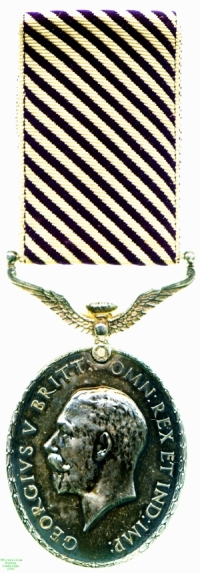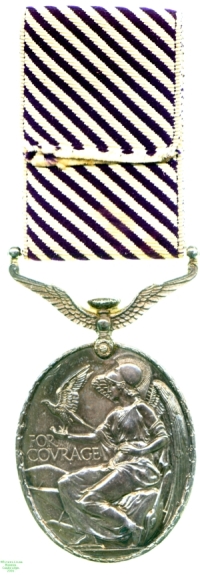Distinguished Flying Medal, awarded to Sgt. Mech. M. Jones between 1918 & 1928

Obverse, a bust of King George V facing left |

Reverse, Victory seated on an aeroplane fuselage with a hawk on her outstretched hand |

Obverse, a bust of King George V facing left |

Reverse, Victory seated on an aeroplane fuselage with a hawk on her outstretched hand |
With the creation of the Royal Air Force in 1918, Army and Navy medals were no longer appropriate awards for acts of gallantry in the air, and new awards were created. The Distinguished Flying Cross was instituted in 1918 for officers, and the Distinguished Flying Medal for NCOs and men. It is still on current issue.
The London Gazette for 29 November 1918 records the award of this example of the medal to Sergeant Mechanic Meyrick Jones of 22 Squadron RAF on p. 14, as follows:
"S/35453 Sjt. Mech. Meyrick Jones (Cricklewood, N.W.). (FRANCE)
"On 16th September this non-commissioned officer displayed exceptional courage and devotion to duty. In an engagement with a Fokker formation he was wounded in the arm; not realising this, the Pilot directed Serjeant Jones to climb on to the right wing to steady the machine, which was almost out of control, owing to the aileron controls being shot away, and was sideslipping down over enemy territory. This he did, and the pilot regained control of the machine, and landed safely at the aerodrome. By this time Serjeant Jones was almost fainting from loss of blood."
Sergeant Jones's story makes an odd comparison with that of the other wing-walking medal-winner whose awards have come into the Watson Collection. Jones's medal was acquired by Lester Watson at some point before 1928. The Museum must thank Graham Neale for assistance with the history of the piece's award.